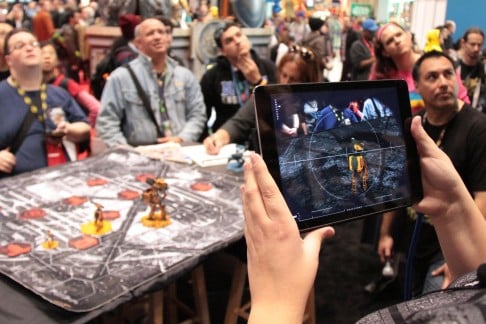
Giant killer robots from Hong Kong: Meet the augmented reality pioneer taking gaming and entertainment to a new level
Platform developed by the company of a Hong Kong-raised graphic designer could become a game-changer

Jason Yim may be on to a game-changer in the future of play among the tech-native generation. His digital marketing company, Trigger Global, has helped create interactive campaigns for movies from the series to In recent years, his team has been using augmented reality to enrich the experience of entertainment, including books and, more recently, tabletop games.
One of his current projects shows the power of this technology.
Imagine playing a game of chess with miniature robots as your pieces. In conventional board games you would roll a dice and physically move your pieces across the "battleground". But with this augmented reality video game, you hold up your tablet so its camera can capture everything that's on the table. The information is reinterpreted and realised on screen as an alternate universe in, say, a devastated city where your robots would clamber through ruins and attack opponents with missiles and cannons. It's chess where the pieces come to life on screen. That's the wonder of augmented reality.
It certainly felt like magic when he first came across that technology several years ago, says Los Angeles-based Yim, who was on a visit to give a presentation at last month's TEDx Hong Kong event.
"When you're just pointing at a poster or you're pointing at a print magazine, it just doesn't feel complete because it's obvious that it's … [just a] marker. But when you can point at an object and the object comes to life, where things are tracking with that physical object, there's magic there."
The augmented reality tabletop game that Yim and his team have been working on is , developed in collaboration with New Zealand's Weta Workshop. Weta is known for creating props and special effects for blockbusters such as trilogy as well as , and which is the why the look and feel of the robots may seem familiar to fans of the sci-fi films.

In fact, that's exactly what piqued 42-year-old Yim's interest in movies, and it inspired the talent behind the toys due for release next year.
Yim, who attended King George V secondary school, still recalls how thrilled he was watching in Hong Kong in the 1970s.
"Right after seeing the movie, we went out to dinner with the family, and I just remember sitting there through the whole dinner trying to move a glass of water, trying to use the Force."
His family (dad was an architect and mum taught interior design) emigrated to the US while he was in his teens, and Yim went on to study graphic design at the University of California Los Angeles.
At the urging of a professor, he started exploring the then emerging internet, which led him to launch a web design company after graduation. In 2005 he left to launch Trigger, initially working out of his own home. Now Trigger employs dozens of developers and 3D artists, and does some US$5 million in business annually,
Getting to where he is now was not easy.
Yim was 22 when he started the first company with some friends from UCLA.
"The internet was so new and we were so inexperienced that we struggled with everything," he recalls. "We worked 14-hour days, almost every weekend, and lived on a diet of instant noodles. But within the first year we landed our first movie project and I would not give up that life experience for the world."
A couple of years after starting Trigger, he opened a studio in Shanghai to tap into the Asian market as well as the wealth of programming talent.

"Our strategy through the tough times was to keep charging ahead. In the end, we're a little battle-scarred, but better for it."
Now with the focus on augmented reality, they have shifted development staff from Shanghai to Los Angeles.
"We worked directly with Qualcomm engineers for many of the projects, sometimes a year before the tech was available to the public. And that level of experimentation required the teams to physically be sitting with each other. It's hard to invent remotely," says Yim, Trigger's executive creative director and CEO.
"So these past two years we've been hovering around the same US$5 million in sales mark. The big difference for us has been efficiency - since we moved development from Shanghai to Los Angeles we've managed to do the same amount of work with almost half the team size."
The team at Trigger has developed other augmented reality projects in the past, such as an app that brings the District 13 hovercraft from the to life, and a more recent app where you can see a 3D image of the ball-shaped BB-9 droid or a Stormtrooper move across your desk, floor or other surface that your phone and tablet is pointed at.

Mike Gonzales, head of consumer products at Weta Workshop, says the platform drew a lot of interest from games developers and visitors at the New York and San Diego Comic Cons.
There was even a military contractor that wanted to adapt the platform into a battle planning tool for the US armed forces.
Augmented reality and virtual reality are both growing sectors, but the former is likely to be far bigger. According to forecasts by specialist investment bank Digi-Capital, virtual reality is expected to become a US$30 billion market by 2020 while augment reality will likely be a US$120 billion industry.
In a report earlier this year, Digi-Capital managing director Tim Merel writes that the immersive experience of virtual reality makes it great for games and 3D films, but augmented reality "has the potential to play the same role in our lives as mobile phones with hundreds of millions of users. You could wear it anywhere, doing anything."
To Weta's Gonzales, their augmented reality project is about merging the digital and physical worlds so that players don't lose one over the other. can work remotely, so players can pit their skills against others around the world from home using their board, pieces and tablet.
It's meant to bring people together in the same space, like Chewbacca and R2D2 and C3PO sitting around the same table to play holochess.
"We're social beings. We're not solitary creatures by nature, and what technology's done to us you see all the time when you walk down Kowloon or Central: everybody's looking down at their phones, no one's interacting with each other," Gonzales says. Recalling a scene in the computer-animated movie , in which humans sit watching screens and slurping drinks without ever talking to each other, he adds: "It's a very tongue in cheek message, but it's so close that it's scary in some ways."
"What we're doing, we're bringing together communities. You think about what Aborigines did out in the Outback: they all got around a fire, they told stories."
When you can point at an object and the object comes to life ... there’s magic there
For now, augmented reality still means looking at a screen; even the head-mounted devices are essentially screens that go directly in front of our eyes.
As the father of a two-year-old daughter, Yim says he is well aware of parental concerns over how much time children spend staring at screens.
But he also points to a statement by the American Academy of Pediatrics at a media research symposium in October that "in a world where 'screen time' is becoming simply 'time,' our policies must evolve or become obsolete". Parents, the academy argued, should focus on the quality of content rather than setting a timer for how long a child is allowed to look at a screen.
"That real balance is not trying to replace the kid's imagination," Yim says. "It shouldn't just be media that they consume. The digital experience should also expand on their creativity, let them do new things, give them abilities they didn't have before … instead of zoning them out and making them zombies watching a screen."
And it's a balance his team is working to address.
Meanwhile, Yim is also developing a game project with toy giant Lego. That allowed him to spend a few months at its headquarters in Denmark, where he visited a vault containing a sample of every brick and toy set that the company ever produced.
Highlighting a photo of himself as a boy with a Lego train set in 1976, Yim says the image captures why the work matters to him.
"To imagine a product I played with when I was four or five, and it's still a visceral memory for me when I'm 42. That's impact. You're doing something that's lasting, in this digital age, that's just getting harder to accomplish," Yim says.
"Tech is going to be part of solving that problem, too. Is there going to some experience with digital eyewear and toys and play that can be so impactful that my daughter will remember it 35 years from now?
"That's my Holy Grail: to create something that has that much lasting impact."
